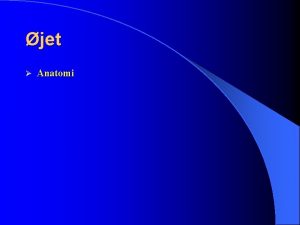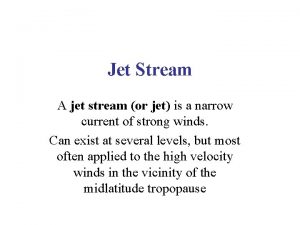JET Programme 2005 Selected issues that could affect










- Slides: 10

JET Programme 2005 Selected issues that could affect LH experiments LH SOL generated fast particles meeting, Prague, 16 -17 Dec 2004 J. Mailloux

JET Experimental campaigns 2005: Main Headlines (as distributed with call for experimental proposals) > Headline 1 (8 sessions): Bringing new systems to full performance: Divertor and Diagnostic, and, in addition, the LH launcher > Headline 2 (68 sessions): Critical issues for ITER (issues having a possible impact on the detailed design of ITER components, such as first wall, heating and CD systems, diagnostics, etc. ) > Headline 3 (39 sessions): Preparation of ITER operating scenarios > Headline 4 (21 sessions): Specific physics issues of direct relevance to ITER and for which JET is unique Greater emphasis on ITER relevant work LH work directly or indirectly relevant to all 4 headlines LH SOL generated fast particles meeting, Prague, 16 -17 Dec 2004 J. Mailloux

JET Experimental campaigns 2005: Planning (from JET announcement of 13 Nov 2004) > Shutdown completion: May 2005 > Plasma restart: June 2005 (17 weeks) > Task Force Experiments start: September 2005 Experiments selection: process starts in January 2005 LH SOL generated fast particles meeting, Prague, 16 -17 Dec 2004 J. Mailloux

JET capabilities in 2005: New/improved diagnostics (1/2) info from http: //users. jet. efda. org/pages/ops-dept/pages/FT/jet 2005 capabilitiesrev 11. pdf > High resolution Thomson scattering: Te and ne profiles for RMAJ= 3. 0 m to 3. 9 m better spatial and time resolution > Bolometer camera: total radiated power and profiles better accuracy and time resolution than present system means re-commissioning of LHCD launcher protection system > Bolometer camera in divertor: total radiated power and profiles in divertor region refurbish system and optimise views > Charge exchange recombination spectroscopy: Ti profiles for RMAJ= 2. 7 m to 3. 7 m better spatial (x 2) and time (x 5 -10) resolution > Edge charge exchange recombination spectroscopy: edge radial profile of Ti > Wide angle infrared view: Temperature distribution of first wall Centred on ICRH antennas in octant 2, can not see LH launcher Not available until end of 2005 > Lost a diagnostic (Faraday cups): poloidal profile of lost fast ions with crude energy resolution and radial profile (incl. ICH tail ions and DT a (3. 5 Me. V)) > Lost a diagnostic (scintillator probe): energy and pitch angle of lost fast ions (incl. ICH tail ions) LH SOL generated fast particles meeting, Prague, 16 -17 Dec 2004 J. Mailloux

JET capabilities in 2005: New/improved diagnostics (2/2) info from http: //users. jet. efda. org/pages/ops-dept/pages/FT/jet 2005 capabilitiesrev 11. pdf > Magnetic proton recoil spectrometer: neutron spectrum in the range 1. 5 - 2. 0 Me. V > Time of flight for optimised rate: neutron spectrum in the range 1 - 5 Me. V > Coils for magnetic measurements: external and internal coils for vertical and radial magnetic field measurements > Halo current sensors: Halo current through plasma and vacuum vessel during plasma vertical displacement events > Toroidal Alfven Eigenmodes antennas: Characteristics of fast particle driven Alfven modes > Microwave access: improve performance of existing reflectometers > Michelson Electron Cyclotron Emission Oblique: Broadband calibrated ECE Te measurements Test departure from a Maxwellian distribution of the bulk electrons > Fast ADC: Provide fast acquisition channels to several systems (including ECE, TAE, NBI) > Replacement/ refurbishment of divertor Langmuir probes and thermocouples: ELM-resolved Te, ne and jsat > Tritium retention studies: several techniques to be used to address problem of T retention in divertor, main chamber, and erosion/deposition on metallic mirrors more details on TFD website, or contact ROs LH SOL generated fast particles meeting, Prague, 16 -17 Dec 2004 J. Mailloux

JET capabilities in 2005: New divertor and improvement of heating systems info from http: //users. jet. efda. org/pages/ops-dept/pages/FT/jet 2005 capabilitiesrev 11. pdf ITER shape high d plasma High field side gap closure tile to protect divertor diagnostics cables Load bearing septum replacement tiles to increase power handling > Divertor Mark II HD (high density) will cope with high power in high triangularity configurations: likely that LH will have to be coupled in new configurations > NBI: optimisation of PINIs and improvement of neutralisation efficiency on octant 8 will result in total power of 25 MW max/20 MW routinely > ICRH JET-EP: not installed this shutdown > ICRH antenna A and B will now be tied, hence switching off antenna B to avoid degrading LH coupling will mean switching off antenna A as well, resulting in severe limitation of the ICRH total power. Operational solutions to be investigated during plasma restart. LH SOL generated fast particles meeting, Prague, 16 -17 Dec 2004 J. Mailloux

4 top rows of LH launcher (2004) Status of LH systems: launcher > Detailed photo survey indicates that existing damage at the grill mouth (top left modules) has evolved further: - Partly because of fast e produced in the SOL? - How does the damage affect the fraction of power in high N// components? > Internal survey of four selected multijunctions indicate no structural damage (i. e. no melting or weld failure like at the grill mouth) > The top left corner protection tile broken (graphite), but this time looks like mechanical failure, possibly due to defect, rather than overheating and erosion like in 2001. Will be replaced this shutdown by CFC tile. LH SOL generated fast particles meeting, Prague, 16 -17 Dec 2004 Top left protection tile (2004) J. Mailloux

Caution, photographs not taken from same angle > Most important damage is to top left of launcher: consistent with plasma - launcher distance (nearer top rows generally), and possibly with trapped fast ion orbits (under investigation) > But smaller scale damage also observed on all rows, centred in the middle of the waveguides: consistent with fast e in the SOL? Or arcs? Evidence for both mechanisms exists (respectively: hot spots, and imbalance trips in coincidence with radiation spike). > No damage on side protection tiles (CFC) LH SOL generated fast particles meeting, Prague, 16 -17 Dec 2004 4 top rows 4 middle rows 4 bottom rows J. Mailloux

Status of LH systems: LH plant 24 klystrons feed 48 multijunctions > Broken window assembly on unit F 3 to be replaced > Broken klystron on unit F 1 to be replaced All units operational > However, problems with klystron fast protection system, especially on module F > Refurbishment project started recently, will have consequences on operation: module F will be unavailable while prototype is installed and tested, likely to occur during experimental campaign (to be confirmed when tendering process finished) Only 5/6 th of the total power available for experiments LH SOL generated fast particles meeting, Prague, 16 -17 Dec 2004 J. Mailloux

Some SOL issues to investigate for LHCD in ITER > Density control with local gas puffing for LH coupling: - What dominates the ionisation process? Does the LH antenna near field plays a role? If yes, through what mechanism? - Can we optimise the gas injection system further? > Wave propagation and non-linear effects: - Significant LH power loss though non-linear effects? Higher LH power loss when coupling through large plasma - launcher distance? - To what extent is the wave spectrum modified by non-linear effects (parasitic electrons, density fluctuations, etc. )? > Do we need 3 -D modelling to extrapolate to ITER? This meeting can help identify other questions, and how to find the answers LH SOL generated fast particles meeting, Prague, 16 -17 Dec 2004 J. Mailloux



















